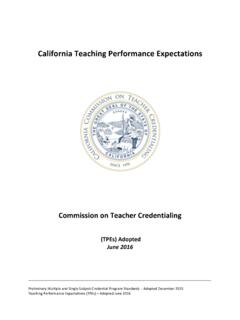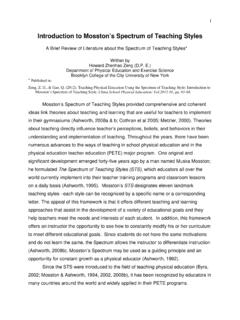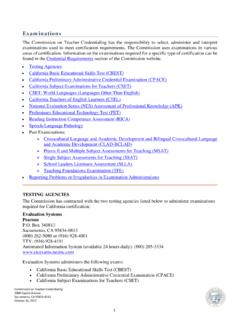Transcription of KNOWLEDGE OF DIVERSE LEARNERS: IMPLICATIONS FOR …
1 International Journal of Instruction July 2010 , e-ISSN: 1308-1470 p-ISSN: 1694-609X. KNOWLEDGE OF DIVERSE learners : IMPLICATIONS FOR. THE PRACTICE OF teaching . Fadzilah Abd Rahman, Jon Scaife, Nurul Aini Yahya & Habibah Ab Jalil Faculty of Educational Studies, University Putra Malaysia, Malaysia KNOWLEDGE of DIVERSE learners (KDL) is increasingly recognized as an essential component of KNOWLEDGE base for effective teaching as in today's schools, teachers must be prepared to teach a DIVERSE population of student (Banks et al. 2005). In other words, teachers need to be aware that their students in a classroom are and always have been different from one another in a variety of ways.
2 KDL. refers to an understanding of diversity of students in terms of their abilities and interests and how they respond to DIVERSE situations; an application of different teaching strategies; and how various types of classroom activities might be managed. Although KDL has come to be seen as important, details of its development, depth and quality among pre-service teachers (PSTs) has remained something of mystery, as has the capability of PSTs to adapt and employ KDL. into their actual teaching . As an effort to develop coherent understanding of the feature of prospective teachers regarding KDL, this paper addresses three questions.
3 First, to what extent are the PSTs prepared for KDL as they are finishing the teacher education programmes? Secondly, how do the PSTs apply the KDL in their teaching practices? Thirdly, how do PSTs reflect on their practice in undertaking the elements of KDL during the teaching practices? This paper illustrates the results of a study involving a sample of 74 PSTs at a university in Malaysia. At the beginning of the study, 74 PSTs were given a questionnaire. 11. PSTs have been observed and interviewed. Result indicates that PSTs were able to develop KDL and show their understanding of it, yet not readily apply such KNOWLEDGE in modified situations Key Words: DIVERSE learners , pre service teachers, perspectives and practices INTRODUCTION.
4 Diversity is an apart of the nature of the human species, and students are and always have been different from one another in a variety of ways (Banks et al., 2005). Recent research studies into effective teaching tend to indicate that 84 KNOWLEDGE of DIVERSE learners . teaching is not any longer considered as a linear process of transmitting KNOWLEDGE from the teacher to students, or from educational materials to students. In turn, the demands on teachers mean that not only they need to be able to keep order and provide useful information to students, but also to be increasingly effective in enabling a DIVERSE group of students to learn ever more complex material and develop a wider range of skills (Arends, 2004; Rivkin et al.)
5 , 2000; and Wright, Horn & Sanders, 1997; Barnes, 1989). Clearly, in today's schools, teachers must be prepared to teach a DIVERSE population of students. Why is KNOWLEDGE to deal with DIVERSE groups of students such an important element in teaching ? Linked to the idea of a KNOWLEDGE base for teaching , Shulman (1987) asserts that in order to teach one needs a breadth and depth of KNOWLEDGE of teaching and a rich factual KNOWLEDGE base with many interconnections which represent a much more thorough understanding than that which is achieved purely as a curriculum learner. He refers to this as pedagogical content KNOWLEDGE , that is, an understanding of how particular teaching , subjects, topics, problems, or issues are organized, presented, and adapted to the DIVERSE interests and abilities of learners , and presented for instruction.
6 This can be seen that teachers have always needed to address the DIVERSE learning needs of their students; current and projected demographic trends prompt many educators to believe that awareness of and sensitivity to DIVERSE learners have become even more pressing needs (Gay, 2003). In existing classroom situations, pedagogical content KNOWLEDGE is recognized as an essential component in assessing pre qualified teachers (PQTs) or in establishing 'quality teaching '. Moreover, pedagogical content KNOWLEDGE has been described as a component of the important knows how' that PSTs should develop during their teacher education programme.
7 Carpenter, Fennma, Peterson, and Carey (1988) claim that pedagogical content KNOWLEDGE was positively linked to the students' achievement. Teachers with stronger pedagogical content KNOWLEDGE were found to represent content more accurately (Gudmundsdottir, 1987, 1990; Wilson and Wineburg, 1988). Calderhead and Shorrock (1997, p. 13), stressed that developing pedagogical content KNOWLEDGE requires not only an understanding of the subject matter , but also an understanding of children, their abilities and interests and how they tend to respond to different situations, and an appreciation of different teaching strategies and how various types of classroom activities might be managed.
8 Thus, it can be considered that teachers have always needed to address the DIVERSE learning needs of their students. International Journal of Instruction, July 2010 , Rahman, Scaife, Yahya & Jalil 85. Defining KNOWLEDGE of DIVERSE learners Since the early 1980s, the study of teachers' KNOWLEDGE has received increasing attention from educational researchers of various disciplines and of different school subjects, particularly in the United States, Canada, and other western countries (Shulman, 1986; Clandinin & Connelly, 1995; Putnam & Borko, 2000). Teachers' KNOWLEDGE also has been conceptualised by researchers in terms of beliefs, practical theories, or KNOWLEDGE in action (Putnam and Borko, 1996; Sch n, 1983).
9 In addition, teachers' KNOWLEDGE has been recognised as teachers' cognition, which includes metaphors, practical KNOWLEDGE , beliefs, images, and events (Carter & Gonzalez, 1993). In describing a category of KNOWLEDGE , it is important to note that any categorization of teachers' KNOWLEDGE and beliefs is somewhat arbitrary and there is no single system for characterising the organization of teachers'. KNOWLEDGE (Putnam and Borko, 1996). As the KBT has grown, fundamental concepts of teaching , learning, learners , and subject matter dynamically change. Thus, there is no definite concept of bounded KNOWLEDGE base for teaching (KBT) on which everyone is agreed.
10 Valli and Tom (1988) claimed that KBT organise the domains of KNOWLEDGE for teaching and guides how the KNOWLEDGE is taught and learned in a teacher education programme. The phrase KBT is also linked to teacher assessment. In designing a new assessment of performance for beginning teachers, Reynolds (1992) first determined the sorts of tasks a beginning teacher should be able to do and then tried to identify what types of KNOWLEDGE and skills are required in order to perform those teaching tasks effectively. Among seven specific categories of teacher KNOWLEDGE proposed by Shulman (1987) (Figure 1), he included a substantial and essential category namely KNOWLEDGE of learners , that is, a specific understanding of the learners '.















